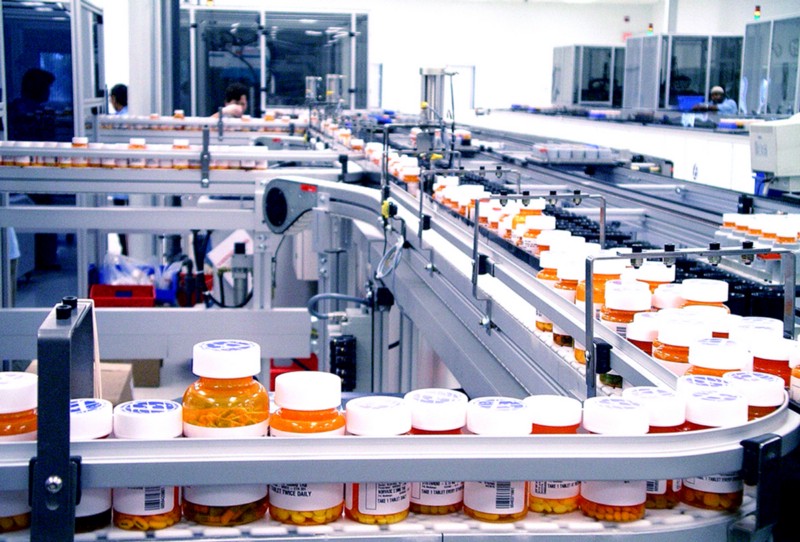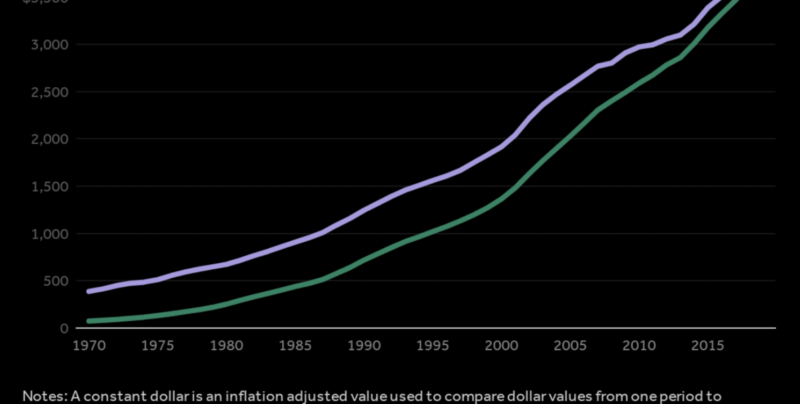
“What Congress should not do is heavily regulate the PBM industry by establishing hundreds of rules about how PBMs are allowed to profit from their business. This kind of Soviet, top-down approach is a terrible way to run an economy, and PBMs will inevitably find ways to game the system. Price transparency is a simpler, more American solution.”
Price-signaling is the backbone of a free market. Prices allow customers, businesses, and investors to decide when there is too much or too little of some good, and to bargain if a good is too expensive. At the bottom of what Adam Smith called the “invisible hand” and Hayek called “spontaneous order” are trillions of price signals from different actors, coordinating the ways that we work together and serve one another.
Piles of academic research have shown that transparent pricing makes goods cheaper for consumers and forces producers to be more efficient. For example, studies of advertising bans in areas from lawyers’ services to eyeglasses show that open price competition brings down costs for all.[1] And a recent study of the relatively noncompetitive hospital market shows that price disclosure brought elective surgery prices down by 5%.[2]
If prices are the code that runs our economic machine, we can fairly say that the Pharmacy Benefit Manager (PBM) industry is a system failure. Because America’s PBM industry is heavily concentrated — with three companies controlling 85% of the market — PBMs have been able to refuse to disclose prices to the insurers, manufacturers, pharmacies, and end consumers that they deal with. This corrupt arrangement is directly responsible for 10s of billions of dollars of waste every year. Here are a few ways that it happens:
1) Secret Rebates
PBMs supposedly negotiate on behalf of insurance companies with drug manufacturers to secure lower real prices on drugs. Rather than asking for a lower “list price” for a drug, the PBM accepts the manufacturer’s list price and then the manufacturer gives the PBM a rebate, some of which is passed on to the insurer, and some of which the PBM takes as a cut.
The issue is that rebate contracts between drug companies and PBMs are protected as “trade secrets.” PBM customers — including Medicare, private insurers, and even their auditors — typically can’t see the terms.[3] Because insurance companies don’t know how much of a cut PBMs are taking, they can’t tell if the PBM “formularies” favor high cost or low-cost drugs or how much money PBMs are making on any particular drug. Right now, insurance companies can’t push back against abusive rent-seeking. If prices were transparent, they could.
2) Spread Pricing
When I go pick up a drug at a pharmacy, the pharmacy is reimbursed by a PBM. The PBM then charges the insurer for the drug. But PBMs routinely charge insurers and government payors way more than they reimburse pharmacies — a practice known as “spread pricing.” A small mark-up would be nothing out of the ordinary, but a recent Bloomberg report found that spreads are sometimes over 1,000%.[4]
The problem is that because PBM-pharmacy contracts are opaque, insurers don’t know how badly they’re being fleeced. And it’s not just private insurance companies who are getting hosed, it’s federal tax payers. In a study of 90 drugs, (including 500 dosages and formulations), the same researchers found that PBMs and pharmacies siphoned off $1.3 billion of the $4.2 billion Medicaid insurers spent on the drugs in 2018.[5] In a competitive market, this kind of egregious profiteering would not exist. Insurers would insist on paying the same price that PBMs reimburse pharmacies, maybe a small service fee attached.
3) The Maximum Allowable Cost List
Another way PBMs manipulate the pharmaceutical drug industry is by refusing to signal prices to pharmacies before the pharmacy sells someone a medicine. Instead, PBMs reimburse pharmacies after the pharmacy has sold a consumer a drug at a rate set on something called the “Maximum Allowable Cost” (MAC) list.
The MAC list is protected as a trade secret, so pharmacies never know what they’ll be reimbursed.[6] Often PBMs reimburse pharmacies at well below the real cost of the drug, and the pharmacy will have to eat the loss — and as representative Doug Collins has argued, PBMs remorselessly use this technique to drive independent, mom-and-pop pharmacies out of business. If MAC pricing formulas were available in advance, pharmacies would be able to determine whether filling a particular prescription is profitable, could insist on the same prices that PBMs award other pharmacies, and could band together to negotiate with the Big 3 PBMs.
These examples illustrate how PBMs use trade secrets to play a shell game with insurers and pharmacies.[7] To be clear, they aren’t the only ways PBMs exact their toll on the pharmaceutical industry — there are ex post facto “direct and indirect remuneration” (or “claw-back”) fees, “administrative fees”, favoring the pharmacies they own with exceptionally low prices, etc.
The problem is that the PBMs are so big and so powerful that they’ve been able to get away with obviously anti-competitive behavior. And the industry has only continued to consolidate, with major mergers between CVS and Aetna and between Express Scripts and Cigna announced last year. It would be no easy task for other industry players to hold PBMs to account in ordinary circumstances. Allowing PBMs to conceal prices in trade secret contracts fundamentally cripples the pharmaceutical drug market’s ability to hold PBMs accountable for their ill-gotten gains.[8]
The Senate recently passed a bill that outlawed “gag orders” by which PBMs kept pharmacists from informing consumers if a cheaper option was available. Concealed prices are a gag order on the entire pharmaceutical industry and must be rejected on the same grounds.
Some organizations, such as ALEC, argue that a market is not truly “free” unless market actors such as PBMs can protect price information as a “trade secret.”[9] We strongly disagree. The purpose of intellectual property law is to allow entrepreneurs to claim ownership over real innovations which improve the lives of human beings in new and beautiful ways, not to allow cartels to secretly price gouge their business partners.
Congress must demand that PBMs disclose rebates on a per-drug basis, administrative fees received from each client, pricing formulas for pharmacies, spread prices, and more. In short, Congress should insist that PBMs disclose every economic transaction they engage in, whether with insurers, manufacturers, pharmacies, wholesalers, or any other possible member of the pharmaceutical industry. The only way to subject PBMs to market discipline is to make every net price available to the public.[10]
One of the few areas that the Trump administration, the Republican Senate, and the Democratic house agree on is the need for more price disclosure in the health care market — and with good reason.[11] As Stanford’s Robin Feldman writes, “markets, like gardens, grow best in the sun. They wither without information.”[12] Forcing sunlight into the dark recesses of the PBM market will empower consumers, health insurers, and others to negotiate better prices and check the power of this questionable oligopoly.
What Congress should not do is heavily regulate the PBM industry by establishing hundreds of rules about how PBMs are allowed to profit from their business. This kind of Soviet, top-down approach is a terrible way to run an economy, and PBMs will inevitably find ways to game the system. Price transparency is a simpler, more American solution.
Republicans should agree that market competition and an informed public are two of our greatest strengths as a civilization. We urge lawmakers to have the courage to insist on them in the areas of our economy where they are needed most.
[1] D. Andrew Austin and Jane Gravelle, “Does Price Transparency Improve Market Efficiency? Implications of Empirical Evidence in Other Markets for the Health Care Sector,” Congressional Research Service, Order Code RL34101, July 24, 2007, https://fas.org/sgp/crs/secrecy/RL34101.pdf
[2] Hans B. Cristensen, Eric Floyd, and Mark Maffett, “The Effects of Price Transparency Regulation on Prices in the Healthcare Industry,” Chicago Booth Research Paper №14–33, 2013, https://www.bakerinstitute.org/media/files/event/01ce2e80/HPF-paper-AHEC-Floyd.pdf; See also Mark V. Pauly and Lawton R. Burns, “Price Transparency For Medical Devices,” Health Affairs 27, no. 6 (November/December 2008), https://www.healthaffairs.org/doi/full/10.1377/hlthaff.27.6.1544
[3]https://www.medpagetoday.com/publichealthpolicy/generalprofessionalissues/79644
[4] CVS would reimburse pharmacies $6 for a bottle of pills and then charge insurance companies almost $200 for the same bottle of pills, pocketing the difference of $192.49! See: https://www.bloomberg.com/graphics/2018-drug-spread-pricing/
[5] Bloomberg, ibid.
[6] https://www.truthrx.org/pbm-faqs.html
[7] Don’t think manufacturers are off the hook; PBMs just extract rents from them with “administrative fees” and in othe
[8] It’s not clear whether antitrust is an appropriate solution, but price transparency is a crucial first step.
[9] https://www.alec.org/model-policy/resolution-opposing-government-mandated-disclosure-of-proprietary-trade-secret-information/
[10] Our proposal is radically more expansive than the proposal advanced by the National Academy for State Healthcare Policy. It’s important not just to insist that rebates are transparent — PBMs can always devise new business models. Nothing short of comprehensive transparency will fix this broken industry. See: https://nashp.org/wp-content/uploads/2018/08/PBM-Model-Act-FINAL-8_9_2018.pdf
[11] Stephanie Armour, “Trump Administration Preparing Executive Order on Health-Cost Disclosure,” Wall Street Journal, May 24, 2019, https://www.wsj.com/articles/trump-administration-preparing-executive-order-on-health-cost-disclosure-11558690320
[12]https://docs.house.gov/meetings/WM/WM02/20190307/109040/HHRG-116-WM02-Wstate-FeldmanR-20190307.pdf

